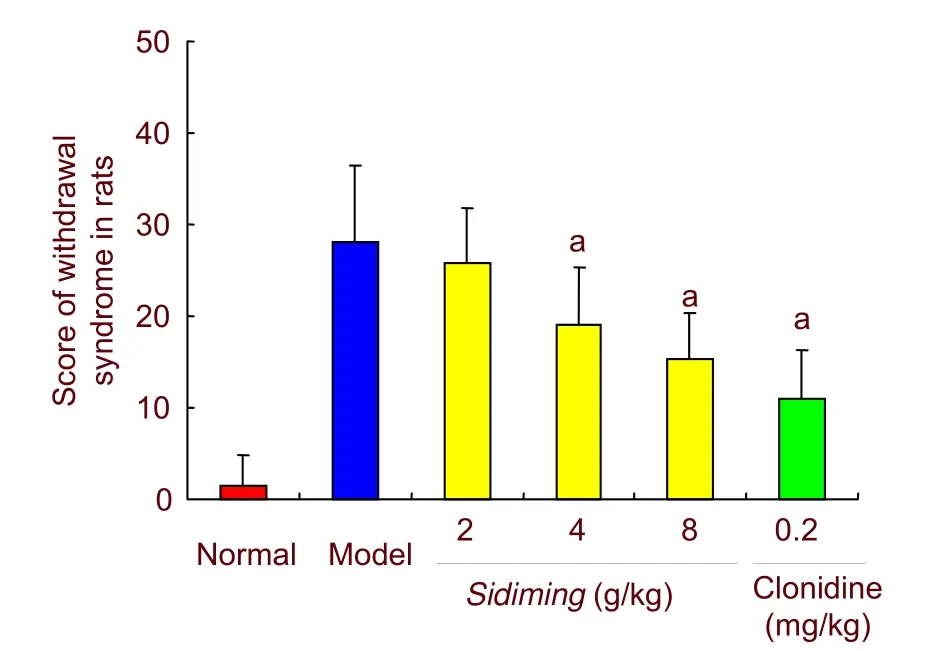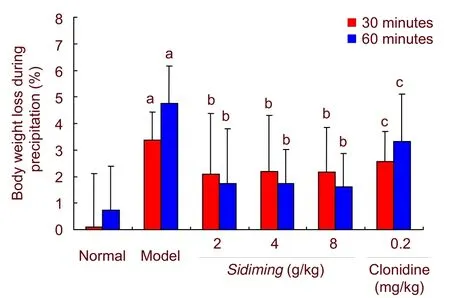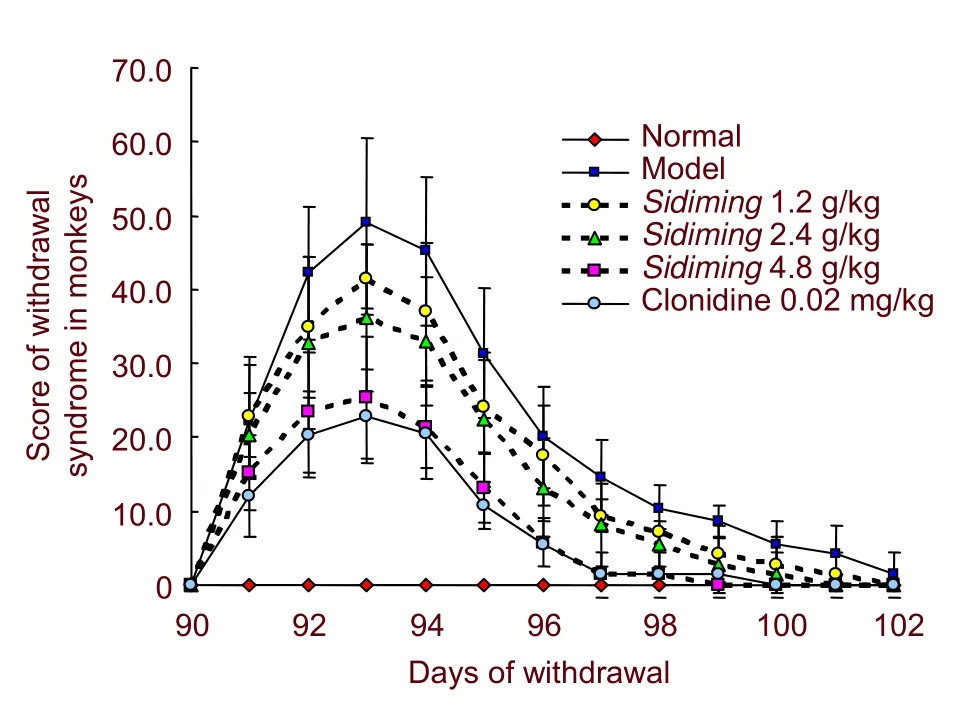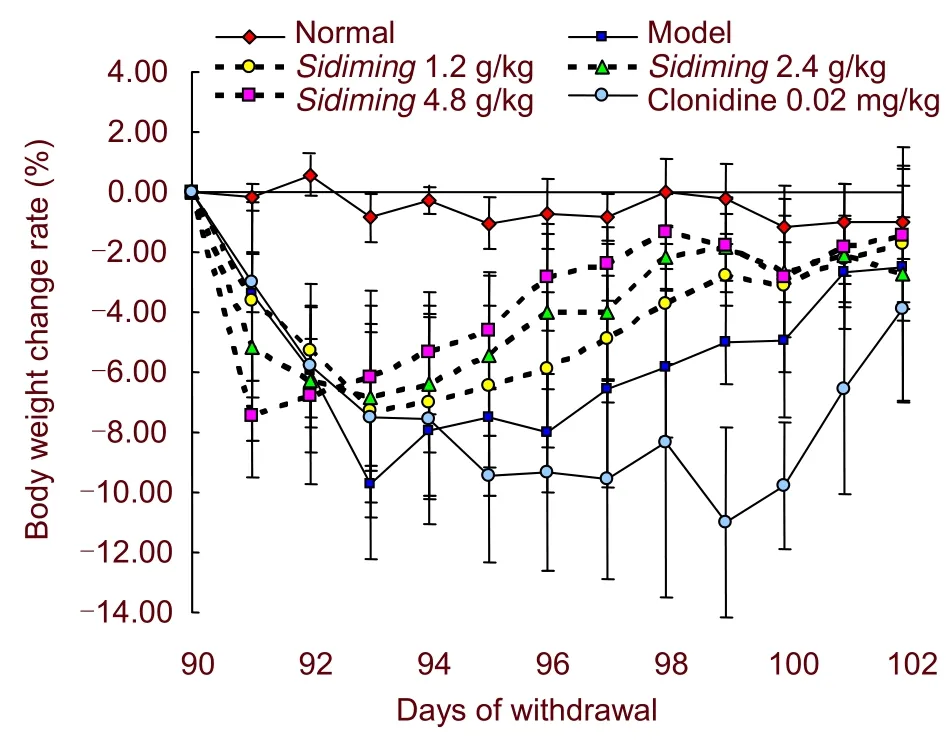Sidiming attenuates morphine withdrawal syndrome and nitric oxide (synthase) levels in morphine-dependent rats and rhesus monkeys*★
2011-07-27
Department of Pharmacology, Guangxi Medical University, Nanning 530021, Guangxi Zhuang Autonomous Region, China
INTRODUCTION
Knowledge of opioid dependence has been exchanged between western medicine and Chinese medicine, resulting in the use of many traditional Chinese medicine preparations in clinical application, includingFukangpills,Yi’andecoction, andShifushengcapsules[1-3].Sidiming, which comprises a series of Chinese herbal medicines, such asRadix Rehmanniae,Coptis Chinensis Franch, andEucommia Ulmoides Oliv, invigorates the kidneys,fortifies the spleen, and activates the blood.A number of studies have demonstrated that withdrawal syndrome and body weight loss induced by chronic morphine treatment in rats is relieved by treatment with Cedemex[4-5], which was the pharmaceutical basis forSidiming.Previous studies have shown that nitric oxide (NO) release is stimulated by morphine application[6-7].However, it remains poorly understood whether the inhibition of NO and nitric oxide synthase (NOS) results in a reasonable anti-withdrawal syndrome effect in animal models, especially in the rhesus monkeys.The present study, therefore, analyzed the effects ofSidiming, a Chinese herbal compound, on withdrawal syndrome, body weight loss, and serum levels of NO and NOS in morphine-dependent rats and rhesus monkeys.These results were compared with clonidine, an active control drug used for clinical treatment.
RESULTS
Quantitative analysis of experimental animals
Sixty Wistar rats and 30 rhesus monkeys were included in the study and randomly assigned to six groups: model, normal, low-,moderate-, and high-doseSidiming, and clonidine.All animals, with exception of the normal group, were subcutaneously injected with morphine for 14 days (rats) or 90 days(rhesus monkeys) for model establishment[4,8].IndividualSidimingand clonidine doses were administered to the respective group of rats and monkeys, except distilled and deionized water was applied to the normal and model groups.One rat in the low-doseSidiminggroup died due to technical failure,but the remaining 59 rats and 30 rhesus monkeys were included in the final analysis.
Sidiming attenuated morphinedependent withdrawal syndrome and body weight loss in rats
Rats were subcutaneously injected with morphine for 14 continuous days and were intragastrically treated withSidiming(2, 4,and 8 g/kg, respectively) from day 10 to day 14 (low-, moderate-, and high-doseSidiminggroups,respectively).One mouse in the low-doseSidiminggroup was died on the morning of day 12, likely due to technical failure.Withdrawal syndrome[4]and body weight changes were recorded during 1-hour naloxone precipitation(Figures 1, 2).

Figure 1 Sidiming attenuates withdrawal syndrome in morphine-dependent rats.Data are expressed as mean ±SD of 10 rats in each group, except nine in the 2 g/kg Sidiming group.aP<0.01, vs. model group (analysis of variance followed by LSD test).Sidiming doses (4 and 8 g/kg) are more effective on withdrawal syndrome scores,whereas clonidine significantly attenuates withdrawal syndrome, compared with the model group.

Figure 2 Sidiming attenuates withdrawal body weight loss in morphine-dependent rats.Data are expressed as mean±SD of 10 rats in each group, except nine rats in the 2 g/kg Sidiming group.Recordings took place twice for 30 minutes each time for 1 hour after naloxone injection.aP<0.01, vs.normal group; bP<0.01, cP<0.05, vs.model group (analysis of variance followed by LSD test).The ability of clonidine to relieve body weight loss is less than Sidiming (2, 4, and 8 g/kg) during 60 minutes of precipitation, compared with the model group.
Greater scores corresponded with more severe withdrawal syndrome.Low-doseSidimingdecreased withdrawal syndrome scores by 8.1%, but these changes were not statistically significant compared with the model group (P> 0.05).Moderate- and high-doseSidimingwere more effective at reducing withdrawal syndrome scores by 31.9% and 45.3%, respectively, compared with the model group (P<0.01).Clonidine significantly attenuated withdrawal syndrome scores by 60.8%,compared with the model group (P<0.01), which was similar to high-doseSidiming(Figure 1).However,clonidine was not as effective at relieving body weight change (P<0.05) as allSidiminggroups, respectively(P<0.01; Figure 2, supplementary Figure 1 online).
Sidiming attenuated morphine-dependent withdrawal syndrome and body weight loss in rhesus monkeys
Monkeys were subcutaneously injected with morphine for 90 continuous days, followed by intragastric administration ofSidiming(1.2, 2.4, or 4.8 g/kg,respectively) or clonidine (0.02 mg/kg) from days 91-97(9: 00-10: 00 a.m.and 5: 00-6: 00 p.m.).Withdrawal syndrome scoring and rate of body weight changes were recorded twice daily within 1 hour afterSidimingadministration, and recording lasted for 5 additional days from days 98-102 (Figures 3-4).Withdrawal syndrome scores were significantly relieved in the high- and moderate-doseSidiminggroups, as well as the positive control clonidine group, compared with the model group(P<0.01).Sidimingdid not significantly reverse body weight loss, but the effects were significant compared with clonidine (P<0.01).

Figure 3 Sidiming attenuates withdrawal syndrome in morphine-dependent rhesus monkeys.Data are expressed as mean±SD of five monkeys in each group,which was recorded twice daily within 1 hour after Sidiming administration.Withdrawal syndrome scores are significantly relieved by clonidine (0.02 mg/kg) and Sidiming (2.4, 4.8 g/kg) (P<0.01, vs.model group) using repeated measure analysis of variance followed by the Bonferroni test.
Sidiming decreased NO serum levels and NOS activity in morphine-dependent rats and rhesus monkeys
As indicated in Tables 1 and 2, NO concentration and activity increased in the serum of morphine-dependent rats and rhesus monkeys (P<0.05 orP<0.01,vs.normal group), but was significantly attenuated by high-doseSidimingin rats (P<0.01) and high-doseSidimingin rhesus monkeys (P<0.01).However,Sidimingexhibited a favorable dose response relationship with regard to inhibition of serum NO and NOS levels.High NO and NOS levels were not relieved by clonidine treatment in morphine-dependent rats or in morphine-dependent rhesus monkeys (Tables 1, 2).

Figure 4 Sidiming attenuates withdrawal body weight loss in morphine-dependent rhesus monkeys.Data are expressed as mean±SD of five monkeys in each group,which was recorded twice daily within 1 hour after Sidiming administration.Sidiming significantly effects anti-body weight loss, compared with clonidine (P<0.01),although it does not significantly reverse body weight change (P> 0.05, vs.model group) using repeated measure analysis of variance followed by the Bonferroni test.

Table 1 Sidiming decreases serum concentration of NO(μmol/L) and activity of NOS (U/mL) in morphine- dependent rats

Table 2 Sidiming decreases serum concentration of NO(μmol/L) and activity of NOS (U/mL) in morphine- dependent rhesus monkeys
DISCUSSION
Proper standardization of the morphine-dependent rhesus monkey models, as well as judgment and dosage of morphine induction, has not yet been established.Based on a previous report[9], the morphine dose was gradually increased over the first three weeks (3, 6, and 10 mg/kg, respectively, followed by maintenance of 15 mg/kg morphine from days 22-90), to provide sufficient time for establishing a morphine response in the monkey.This likely allowed for steady and apparent withdrawal syndromes following morphine discontinuation.
Drug dependence was exhibited as compulsive drug administration with consecutive craving behaviors, and this was likely involved in learning and memory functions.In a recent study, NO was shown to be mediatedviathe classical vasodilation process and was also involved in the formation of learning and memory[10]; NOS, the key enzyme for NO formation,induces endogenous NO discharge when catalyzed by L-arginine.NO plays a role in disseminated neurotransmitters by activating soluble guanylate cyclase in combination with Fe2+ion, which allowed guanosine triphosphate to permit cyclic guanosine monophosphate (cGMP) release.cGMP regulates substrate protein phosphorylation, which is the result of cGMP-dependent protein kinase activation, to increase cyclic adenosine 3', 5'-monophosphate concentrations in the central nervous system, thereby aggravating morphine withdrawal syndrome.In the present study,NO concentration and NOS activity in serum of rats and rhesus monkeys decreased following treatment withSidiming(4 and 8 g/kg for rats and 2.4 and 4.8 g/kg for rhesus monkeys, respectively), but clonidine exhibited a limited effect on NO and NOS.These findings indicated that withdrawal syndrome was likely attenuated by relieving increased NO and NOS serum levels whenSidiming, instead of clonidine, was administered[11].Clonidine exhibits certain attenuation effects on morphine withdrawal syndromeviaα2-adrenoceptor activation and, consequently,inhibition of paradoxical discharge on locus coeruleus neurons during withdrawal.However, increased α2-adrenoceptor activity is thought to induce NO release by increasing NOS activity, resulting in a hypotensive effect by clonidine[12-13].
In summary, the present study showed thatSidimingadministration attenuated withdrawal syndrome in morphine-dependent rats and rhesus monkeys.NO release was also down-regulated due to inhibition of NOS activity.However, further studies are needed to determine whetherSidimingresults in an anti-drug dependence effect by influencing the NO-cGMP pathway in the central nervous system, as well as whether NO and NOS act on morphine dependenceviamechanisms of NO-cGMP signal regulation.
MATERIALS AND METHODS
Design
A randomized, controlled, neuropharmacological animal study
Time and setting
All experiments were performed at the Department of Pharmacology and Animal Experimental Center of Guangxi Medical University, China from September 2006 to July 2007.
Materials
Animals
A total of 60 male, Wistar rats, aged 6-10 months and weighing 200-220 g, were provided by the Experiment Animal Center of Guangxi Medical University, China(license No.SCXK (Gui) 2003-0005).The rats were housed in metal cages with controlled humidity and temperature under a 12-hour light/dark cycle (8: 00 a.m.to 8: 00 p.m.) with food and water available freely.All testing was performed during the dark portion of the light/dark cycle.A total of 30 rhesus monkeys (Guangxi Weimei Bio-Tech, Nanning, China; license No.SCXK(GUI) 2002-0001), weighing 3-4 kg and aged 2-3 years,were utilized in the experiments.All monkeys were individually housed in stainless steel cages in a monkey room with controlled temperature between 22°C and 28°C and ambient relative humidity of 40% to 70%, with a 12-hour light/dark cycle (8: 00 a.m.to 8: 00 p.m.).The monkeys were allowed free access to water, with exception of the experimental session.Conjugated piglet feed (Guangxi Nanning Kangjialong Feed, Nanning,China), fresh fruit, and vegetables were fed daily at 8: 30 a.m.and 4: 30 p.m..All animals were maintained in accordance with theGuidance Suggestions for the Care and Use of Laboratory Animals, formulated by the Ministry of Science and Technology of China[14].The experimental protocol and animal facilities were performed according to the Association for the Assessment and Accreditation of Laboratory Animal Care and approved by the Institutional Experimental Animal Care and Use Committees.
Drugs
Sidimingwas developed by the Department of Pharmacology, Guangxi Medical University, China.The entire composition (100 g), which includedCoptis,Rehmannia,Japonicus,Radix Asparagi,Eucommia,Achyranthes,Dark Plum Fruit,andPilose Asiabell,was added to eight times the volume of distilled and deionized water and was steamed twice for one hour each.The suspension was filtered and condensed to a relative density of 1.14-1.15, and then ethanol was added to a concentration of 75% over a 12-hour period.The complex was dried using the microwave vacuum method, which resulted in a dry powder with 3.32 g total medicinal substances (subsequentSidimingis presented as gram of total medicinal substances per gram)[15-16].The resulting drug was suspended in deionized water and administered intragastrically.TheSidimingsuspension was adjusted to 0.2, 0.4, and 0.8 g/mL,respectively, for rats and 0.4, 0.8, and 1.6 g/mL,respectively, for monkeys.
Methods
Establishment of morphine-dependent rat and rhesus monkey models
The rats were acclimatized in an animal room for 7 days and then were randomly assigned, with 10 rats per group.Rats in all groups were treated over four periods of 14 continuous days with morphine (morphine hydrochloride;Qinghai Pharmaceutical Factory, Xining, China; lot number: 20060603), which was dissolved in physiological saline to form a solution.The morphine hydrochloride solution was adjusted to 0.5, 1, 1.5, and 2 mg/mL, respectively, for subcutaneous induction of morphine-dependent rat models[4]: days 1-4 (5 mg/kg per day), days 5-8 (10 mg/kg per day), days 9-11 (15 mg/kg per day), and days 12-14 (20 mg/kg per day).The normal group was treated with 14 continuous days of subcutaneous physiological saline.The morphine dose was delivered twice daily (9: 00 a.m., 5: 00 p.m.) with an injection volume of 5 mL/kg.A total of 165 mg/kg morphine was administered to the rat groups, with exception of the normal group.
Monkeys were acclimatized in the individual cages in an animal room for 14 days and then randomly divided, with 5 monkeys per group.The monkeys were treated over four periods of 90 continuous days of morphine induction:days 1-7 (3 mg/kg per day), days 8-14 (6 mg/kg per day),days 15-21 (10 mg/kg per day), and days 22-90(15 mg/kg per day).The normal group was treated 90 continuous days of subcutaneous physiological saline[12].Morphine was subcutaneously injected 3 times daily (9: 00 a.m., 3: 00 p.m., and 9: 00 p.m.) with an injection volume of 1 mL/kg.Each monkey received a total of 3 504 mg/kg morphine, with exception to the normal group, during 90 days of treatment.
Effects of Sidiming on naloxone-induced withdrawal syndrome in morphine-dependent rats
Since day 10 of morphine treatment, rats from theSidiminggroup were intragastrically treated withSidiming(2, 4, and 8 g/kg, 10 mL/kg) twice daily (9: 30 a.m.,5: 30 p.m.), while rats from the normal and model groups were treated with deionized water (10 mL/kg) for a total of 5 continuous days.All rats, except the normal group,which was treated with saline (10 mL/kg), were treated with morphine (15 mg/kg, 10 mL/kg) on day 15 (8: 30 a.m.), which was immediately followed by treatment with deionized water (normal and model group, 10 mL/kg),clonidine (clonidine group, 0.2 mg/kg, 10 mL/kg;clonidine hydrochloride tablet was provided by Changzhou Pharmaceutical Factory, Changzhou, China;lot number: 0608012) dissolved in deionized water to form a concentration of 0.02 mg/mL, orSidiming(2, 4,and 8 g/kg, 10 mL/kg).Naloxone (4 mg/kg, 10 mL/kg;naloxone hydrochloride injection provided by Beijing Sihuan Medicine Technology, Beijing, China; lot number:0702261) was diluted in physiological saline at a concentration of 0.4 mg/mL, and treatment were administered to all rats at one hour after the final morphine treatment.Precipitation of withdrawal syndromes[4]were observed four times for 15 minutes each, and body weight loss was recorded at the 0.5-hour and 1-hour points after naloxone injection.
Effects of Sidiming on withdrawal syndromes and body mass in morphine-dependent rhesus monkeys
All monkeys were deprived from morphine from day 91,followed by treatment with deionized water (normal and model group, 1 mL/kg), clonidine (clonidine group,0.02 mg/kg, 1 mL/kg) orSidiming(1.2, 2.4, and 4.8 g/kg,3 mL/kg) twice daily (9: 00 a.m., 5: 00 p.m.) for seven continuous days from days 91-97.Withdrawal syndromes[8]were observed for 1 hour after treatment with deionized water, clonidine, orSidiming(9: 00-10: 00 a.m., 5: 00-6: 00 p.m.), and body weight loss was recorded after each withdrawal syndrome observation for 12 continuous days (days 91-102).
NO and NOS assay in rat and monkey serum
Rat blood samples were collected by eye supra-orbital vein following final withdrawal syndrome observations and body weight recordings.Rhesus monkey blood samples were collected from the small saphenous vein after the final body weight recording on day 102.Samples were centrifuged at 3 000 ×gfor 15 minutes at 4°C following stabilization at room temperature for 30 minutes.Serum was stored at -80°C until further use.NO levels and total NOS activity were determined using a NO assay kit (Nanjing Jiancheng Bioengineering Institute; lot number: 20061211) and total NOS assay kit(Nanjing Jiancheng Bioengineering Institute, Nanjing,China; lot number: 20061212), respectively, according to manufacture instructions.
Statistical analysis
All data were presented as mean±SD.Statistical analysis of all results was performed with SPSS 13.0 software for Windows (SPSS, Chicago, IL, USA).One-way analysis of variance, followed by the LSD test for mean comparison, was applied for analysis of morphine-withdrawal symptoms and body weight loss in rats, as well as NO and NOS comparisons in rats and rhesus monkeys.Physiological scoring and body weight loss in morphine-withdrawal rhesus monkeys were analyzed using repeated measure analysis of variance followed by the Bonferroni test for mean comparison.P<0.05 was considered statistically significant difference.
Author contributions:Zheng Yang was responsible for study proposal, design, operation, data acquisition, and writing of the manuscript.Renbin Huang was responsible for funding and validation of the study, and also serves as the corresponding author.Jianchun Huang, Shijun Zhang, Xing Lin, and Yang Jiao participated in study implementation.Weizhe Jiang was responsible for data analysis and statistical analysis.
Conflicts of interest:None declared.
Funding:This study was financially sponsored by the Natural Science Foundation of Guangxi Zhuang Autonomous Region,No.0575066.
Ethical approval:This study was approved by the Ethics Committee of Guangxi Medical University, China.
Supplementary information:Supplementary data associated with this article can be found, in the online version, by visiting www.nrronline.org, and entering Vol.6, No.33, 2011 item after selecting the “NRR Current Issue” button on the page.
[1] Wang X, Li SX, Zhu SP, et al.Systematic review of effectiveness and safety of Fukangpian in the treatment of opiate withdrawal symptoms.Zhongguo Xunzheng Yixue Zazhi.2004;4(8):545-549.
[2] Liu RK, Xu GZ, Duan LX, et al.Evaluation on phase IV clinical trail of Yi An oral liquor for detoxification of heroin addicts.Zhongguo Yaowu Yilai Zazhi.2001;10(3):200-203.
[3] Deng YP, Shen LY, Gao WY, et al.Multi-centered clinical trail of Shifusheng capsule for the management of heroin withdrawal.Zhongguo Yaowu Yilai Zazhi.2006;15(2):28-32,41.
[4] Xie HY, Lai S, Huang JC, et al.The intervening and therapeutic action of the Cedemex on the withdrawal syndromes of morphine-dependent rats.Guangxi Yike Daxue Xuebao.2007;24(2):231-232.
[5] Xie HY, Lai S, Huang JC, et al.Effect of Cedemex on cAMP and cGMP levels of different brain areas in morphine withdrawal rats.Zhongguo Zhongyao Zazhi.2008;33(12):1439-1443.
[6] Tseng L, Mazella J, Goligorsky MS, et al.Dopamine and morphine stimulate nitric oxide release in human endometrial glandular epithelial cells.J Soc Gynecol Invest.2000;7:343-347.
[7] Wong CS, Hsu MM, Chou YY, et al.Morphine tolerance increases[3H]MK-801 binding affinity and constitutive neuronal nitric oxide synthase expression in rat spinal cord.Br J Anaesth.2000;85(4):587-591.
[8] Seevers MH.Opiate addiction in the monkey I: methods of study.J Pharmacol Exp Ther.1936;56(2):147-156.
[9] He YL, Wang HX, Li JH, et al.Experiment of model formation on morphine-dependent rhesus monkey.Sichuan Shengli Kexue Zazhi.2005;27(3):121.
[10]Susswein AJ, Katzoff A, Miller N, et al.Nitric oxide and memory.Neuroscientist.2004;10(2):153-162.
[11]Zhou JF, Yan XF, Ruan ZR, et al.Heroin abuse and nitric oxide,oxidation, peroxidation, lipoperoxidation.Biomed Environ Sci.2000;13(2):131-139.
[12]Soares de Moura R, Rios AA, de Oliveira LF, et al.The effects of nitric oxide synthase inhibitors on the sedative effect of clonidine.Anesth Analg.2001;93(5):1217-1221.
[13]Dobrucki LW, Cabrera CL, Bohr DF, et al.Central hypotensive action of clonidine requires nitric oxide.Circulation.2001;104(16):1884-1886.
[14]The Ministry of Science and Technology of the People’s Republic of China.Guidance Suggestions for the Care and Use of Laboratory Animals.2006-09-30.
[15]Huang JC, Huang RB, Liu GP, et al.Effects of Sidiming on serum and urine morphine concentration in morphine-dependent rats.Zhongguo Xinyao Zazhi.2008;17(17):1499-1502.
[16]Huang JC, Yang Z, Chen J, et al.Effect of Sidiming on glutamic acid content of the brain cortex and hippocampus in morphine withdrawal rats.Zhongguo Yiyuan Yaoxue Zazhi.2009;29(1):1-3.
杂志排行
中国神经再生研究(英文版)的其它文章
- Effects of Fujian tablet on Nogo-A mRNA expression and plasticity of the corticospinal tract in a rat model of focal cerebral ischemia*☆
- Dynamic analysis of 10 components of the Chinese herbal compound Wuzhuyu-tang absorbed into rat plasma**☆
- Quiet rest ameliorates biochemical metabolism in the brain in a simple concussion rabbit model Evaluation of hydrogen proton magnetic resonance spectroscopy*☆
- Effects of Shuyusan on monoamine neurotransmitters expression in a rat model of chronic stress-induced depression*★
- Effects of electroacupuncture at Zusanli (ST 36) on neurons in the colonic myenteric plexus in rats with irritable bowel syndrome with constipation*★
- Magnetic resonance imaging characteristics of postoperative intracranial dissemination of recurrent gliomas*****☆
